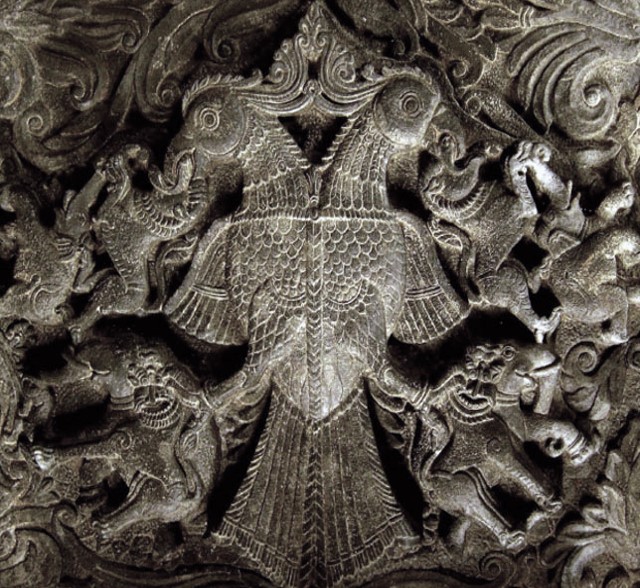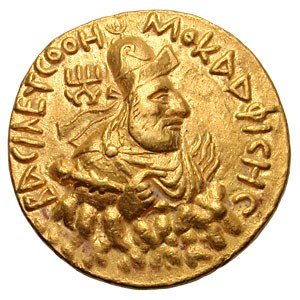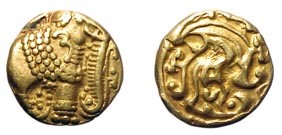The Cholas of Tanjavur
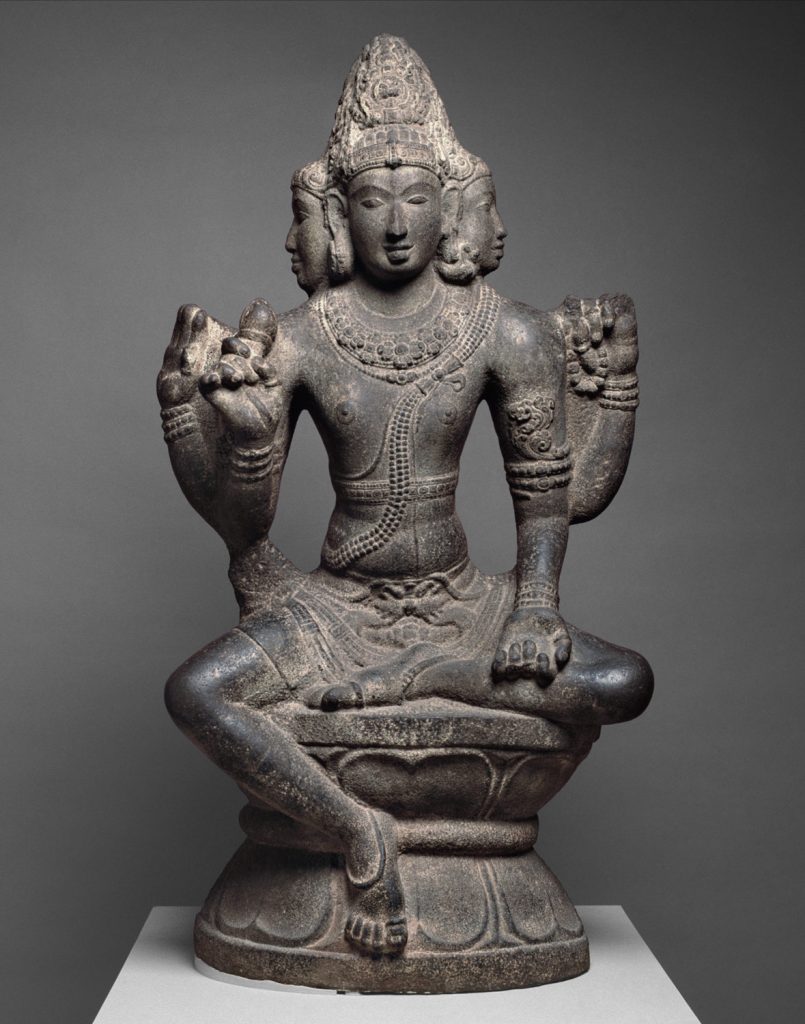
Cholas is an ancient dynasty of southern India having roots in Indian mythology. It was in 850 AD, Vijayalaya Chola, a feudatory of Pallava captured Tanjore (or Tanjavur) and brought Chola dynasty to prominence once again. His son Aditya Chola (871-907 AD) squarly defeated Pandyas and Pallawas, two other major power brokers of South India to become sovereign ruler of south India. Raja Raja Chola (985-1014 AD) was the greatest ruler of this dynasty. He first destroyed Chera (the rulers of Kerala, south India) navy at Trivendrum, then captured Madura and subsequently defeated Sri Lankan king Mahendra V, thus occupying northern Sri Lanka. He later conquered Maldive islands too.
His son Rajendra Chola (1012-1044 AD) was a very worthy successor. He expanded his inherited empire by occupying whole of Sri Lanka (1018 AD) and later crowning the glory by inflicting a crushing defeat on Shrivijaya, the King of Indonesia, in 1025 AD. His empire consisted of whole of southern India, Sri Lanka, parts of the Malay peninsula (modern Malysia) and the Sumatran-based Srivijaya Kindgom (modern Indonesia). His successors managed to retain control for another century without losing any of their mainland territory. Eventually Chola empire disintegrated and former feudatories, Banas, Kadavas and Pandyas assumed independence. Rajaraja Chola III (1216-1246 AD) was reduced to the rank of minor king. Later his capital was captured by Pandya King Jatavarman Sundara and Chola dynasty came to an end.
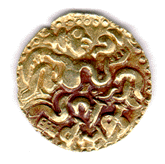
Anonymous coin of Sri lanka
Prototype Used by Raja Raja Chola
990-1017 AD
Gold Kahavanu
Minted in Shri Lanka in 933 AD
Reference: Mitchiner 1998:311
Weight: 4.7 gm
Cholas were great patrons of literature, philosophy, art and architecture. Raja Raja I was responsible for construction of magnificent temple at Tanjore. This temple, which is dedicated to Lord Shiva (also called Brihadishwara) is a masterpiece of architecture. It is built out of the red sandstone with large number of sculptures carved outside and inside involving immense labor and infinite pain. Chola art is characterized by a massive grandeur truly reflected in this massive temple which consists of great `Shikhara’ of fourteen stories, crowned by massive dome carved out of a single stone which weigh about 80 tons!! It is believed that to install this dome on the temple (which is of 190 feet height), a ramp of 5 miles was constructed. A famous historian Fergusson has written `Chola artists conceived like giants and finished like jewellers’. The picture of this magnificent temple is shown above.
Shown above is the gold coin of Sri Lanka which was used as prototype by Raja Raja Chola when he conquored Shri Lanka. King (most likely) is shown sitting and holding conch in one hand. He took the title of `Lankavibhu’, the Lord of (Sri) Lanka. This title, which was written in Devanagari script, is seen on the obverse of coin. Chola empire was eventually disintegrated and Nayakas (Chola governor) took control of Tanjavur. In 16th century, brother of Shivaji the great, defeated Nayakas and firmly established the Maratha dynasty of Tanjavur, which ruled for next 200 years.
Hoysalas of Dwarasamudra
After death of Someshwara III, the Chalukyan empire started it’s decline. After two centuries of rule, in 1190 AD this dynasty disintegrated and their territory was divided among three separate Kingdoms: Hoysalas of Dorasamudra, Kakatiyas of Warangal and Yadavas of Devgiri. Hoysalas occupied all of modern Karnataka region, Kakatiyas occupied modern Telangana/Andhra Pradesh region, while Yadavas occupied modern Maharashtra region.
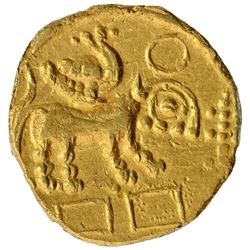
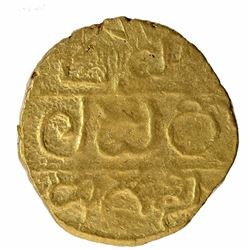
Vinayaditya
Hoysala Dynasty of Dwarasamudra, 1047-1098 AD
Gadyana, Single Die struck, Weight: 4.01 gm, Gold
Obverse: Within linear circle, a maned mythical lion Sardula to right, a lamp stand (or an ornamental pillar) in front. Above lion is a double-headed bird Gandabheruda. Sun is to the right and moon to the left. Below Lion are two rectangular objects, most likely representing pedestal.
Reverse: Legend in Kanarese Sri Ma/ laparo/ lugonda
Reference: K. Ganesh # 8.4
Extremely Fine,
Beautiful specimen, Extremely Rare
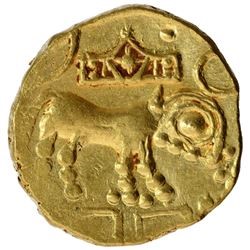

Vinayaditya
Hoysala Dynasty of Dwarasamudra, 1047-1098 AD
Gadyana, Single Die struck, Weight: 4.0 gm, Gold
Obverse: A maned mythical lion Shardula to right. Above lion is an ornamental Doorway, `Torana’. Sun is to the right and moon to the left. Below Lion are traces of two rectangular objects, most likely representing pedestal.
Reverse: Within linear circle, legend in Kanarese Sri Malaparolugonda
Reference: K.Ganesh #8.5
almost Extremely Fine, Extremely Rare,
Vinayaditya, who was a feudatory of Western Chalukyas, was the first to shrug off weakening Chalukyan power and brought Hoysala kingdom to prominence. Vinayaditya called himself Malaparolugonda (Lord of the Hills, from the original homeland in the western mountains of south India). First gold coins of Hoysala dynasty were probably minted by him. There are at least four types coins he minted, all with different obverse, but share the reverse Kanarese legend, Sri Malaparoluganda.
The first coin has double-headed bird, a famous GandaBherunda depicted on top of the mythical lion, Sardula (shown above, the top coin). The sun is shown on right while moon is on left. A lamp is shown in front of Sardula, a reminiscent of Eastern Chalukyas showing lamp before Varaha! Both Sardula and GandaBherunda are mythical creatures. GandaBherunda is a double-headed eagle with peacock tail, having the strength to fly with four elephants! This is considered as a form of NaraSimha, an avatar of Lord Vishnu, described in more details below in Vijayanagara section. Sardula is a Lion like creature, the deity Chamundi (Shakti or Durga in her fierce form) is supposed to be riding Sardula, however, she is not shown on Vinayaditya’s coins (but see on Vishnuvardhan’s coins, shown below).
The second type have Torana or ornamental gateway above Sardula (shown above, the second coin). Sun and moon are seen too. Instead of Torana, Ambari and Umbrella above Sardula are also known.
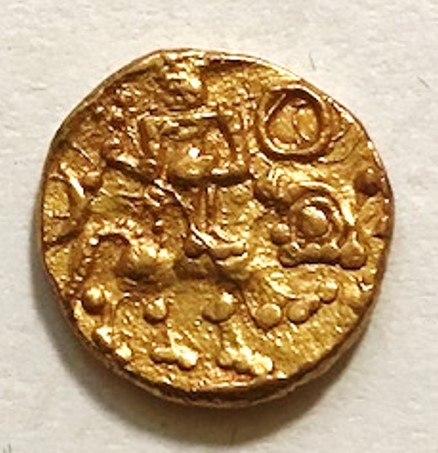
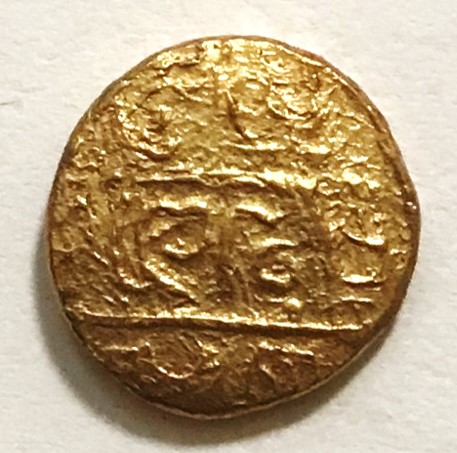
Vishnuvardhan
Hoysala Dynasty of Dwarasamudra, 1108-1142 AD
Gadyana, Single Die struck
Weight: 4.1 gm, Gold
Obverse: Deity Chamundi riding a maned mythical lion Sardula to right. Sun is to the right and moon to the left.
Reverse: Legend in Telugu-Kanarese, Nombavadigonda
Reference: M1998:202; Mitch-704/706, Chattopadhyay#336
Very Fine
Extremely Rare
Vishnuvardhan was perhaps the greatest ruler of the Hoysala dynasty, not only he excelled in multiple wars, but also took great interest in building his kingdom, especially his capital Dwarasamudra (modern Halebidu) and Belur (the earlier capital). Two of the finest temples of south India, ChennaKeshanva temple at Belur, dedicated to Lord Vishnu and Hoyasaleshwara temple at Halebidu, dedicated to Lord Shiva, were built by him. Some of the finest and most intricately carved sculptures are located in these two temples. A masterpiece is the well known sculpture of the Mohini, an avatar of Lord Vishnu when he took a form of a beautiful maiden to take up a task of distributing nectar, carved on one of the pillars of ChennaKeshava temple (shown on right).
The most common type of Vishnuvardhan’s coins have deity, Chamundi, riding mythical Lion, Sardula. The sun and moon are shown. The reverse has Kanarese legend, Nombavadigonda (shown above). There is a second variety with Kanarese legend Talakadugondah, which was likely to be minted soon after his conquest of Gangas of Talkad.
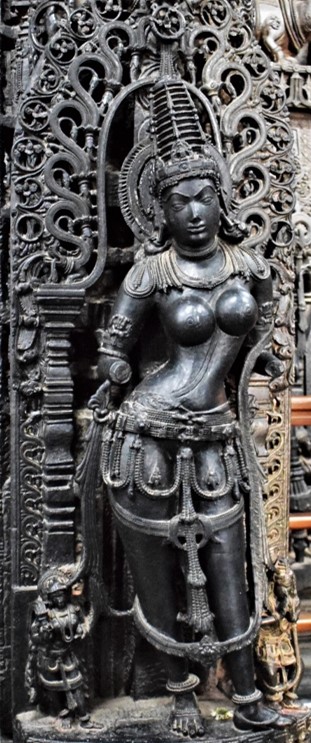
Gangas of Talakad (Western Gangas)
Ganga Dynasty realm was sandwiched between two major power brokers, Pallava/Chola in south and Chalukyas/Rashtrakutas in north, which made this dynasty rulers often siding with their northern neighbors to save their territory. Initially they became vassals of Eastern Chalukyas (of Vatapi or Badami) and later the Rashtrakutas. They also had matrimonial relations with Chalukyan rulers. However, by 1000 AD, Cholas of Tanjavur became too powerful, who annexed the Ganga kingdom in their growing empire.
To distinguish from Ganga dynasty of Orisa (in eastern coast of India), this dynasty is often called as Western Gangas. This dynasty continue to have the artistic scrollwork derived from Eastern Chalukyan coins on the reverse of their coin. The scrollwork is inspired from the windows of the Virupaksha Temple of Pattadakal, built by Chalukyan king, Vikramaditya II. The obverse of their coins adorned with Caparisoned elephant, which is also depicted in the temple of Talakdu, their capital (in modern Karnataka).
In spite of being a relatively small kingdom, a multiple stone inscription, temples and literary works from this dynasty has survived. The greatest of all is the Gommateshwara (also known as Bahubali) statue, the tallest monolithic statue in the world (it is 58 foot tall), carved out of a single granite block! It was a commander-in-chief and the minister of Ganga Dynasty, Chamundaraya or Chavundraya, who completed this statue in 981 AD. This colossal rock cult monolith has two inscriptions at the base, one in old Kannada and other in old Marathi (in Prakrit script). This is considered to be the oldest surviving Marathi inscription.
Kadambas of Hangal
Kadambas is an ancient dynasty of south India who primarily ruled the region which is present day Goa state and nearby Konkan region (part of modern Maharashtra and Karnataka state). The early rulers of this dynasty established themselves at Vaijayanti or Banavasi in 345 AD and ruled as independent rulers for more than 2 centuries. In 607 AD, Chalukyas of Vatapi sacked Banavasi and Kadamba kingdom was incorporated into expanding Chalukyan empire. In eighth century AD, Chalukyas of Vatapi were overthrown by Rashtrakutas who ruled supreme in south India till 10th century. In 980 AD, descendents of Chalukyas and Kadambas rose against Rashtrakutas and Rashtrakuta empire fell resulting in establishment of second Chalukyan dynasty (called Western Chalukyas). Chatta Deva, a scion of Kadamba family who helped Western Chalukyas in this coup, re-established Kadamba dynasty. He was mostly a feudatory of Western Chalukyas but his successors enjoyed considerable independence and were almost soverign rulers of Goa and Konkan till 14th century AD. The successors of Chatta Deva occupied both Banavasi and Hangal and are known as Kadambas of Hangal. Later Kadambas kept paying nominal allegiance to other major power brokers of Deccan like Yadavas and Hoysalas of Dorasamudra and thus mantained their independence. Four different families of Kadambas ruled in southern India which were Kadamabas of Hangal, Kadambas of Goa, Kadambas of Belur and Kadambas of Banvasi.


Shantiverma
1075-1094 AD
Gold Pagoda, Punch-marked type
Obverse: Nine puinch-marks
Reverse: Single punch-mark
Weight: 3.5 gms
Ref: ONS manuscript
Rare
Recent research has given an indication that there were two types of gold coins, that were issued by Kadambas.
1. Punch-marked gold coins (an example shown above)
2. Die struck gold coins (an example shown below)
Kadamba coins were one the heaviest and perhaps purest of all medieval Indian gold coinage, which were maintained with remarkable accuracy. Shown above is an excellent example of Kadamba punch-marked gold coin which is issued in name of Chalukya ruler Jaysimha II Jagadekamalla. It is very likely that, Kadambas issued the punch-marked coinage under influence of similar coinage of Jagadekamalla. This coins has nine distinct punches on obverse while one punch on reverse. The punch on reverse was often struck in such a way that it is hardly visible on most coins, thus giving this series appearance of being uniface. The arrangement of symbols punched on this coin consists of a central punch mark representing figure of monkey god, Hanumana, running to right and four retrospectant lions (dynastic emblem of Kadamba family at the cardinal points around the central punch mark. The two prominent punch marks create two Shri alphabets in Telugu-Kanarese script which depicts Laxmi, goddess of wealth. The eighth punch mark creates a triangular motif and the ninth punch mark represents Telugu-Kanerese inscription on these coins, which reads JaGaDa. One specimen of this type of coin have an extra legend, engraved in Telugu-Kanarese script, which read TiVaRa giving us the name of the king as Shantivarma
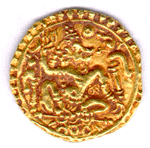
Unknown ruler, Kadamba Dynasty
12th Century AD
Gold stater/Pagoda, Die struck type
Obverse: Monkey god Hanumana sitting
Reverse: Scrollwork
Weight: 4.2 gms
Ref: Mitchiner1998:229
Rare
Toyimadeva (1065 AD) was ruler of this dynasty who perhaps issued first die struck gold coins. These coins are similar in weight and size to Kadambas of Goa. Compared to Goa Kadambas, coins of Kadambas of Hangal are relatively scarce and never been studied in greater details. Shown above is an excellent gold coin of this dynasty which show monkey god Hanumana, seated within a circle of dots and lined circle. Hanumana is flanked by two chouries and conch. On right hand upper corner is sun while towards left hand upper corner is moon. Below is the legend Nakara in Telugu-Kanarese script. Interestingly, the posture of Hanumana on these coins have striking resembalance to the coins of Raja Raja Chola (Shown above). The legend Nakara represents the city deity of Banakapura, Nakareshwara. The reverse show scrollwork within border of lotus petals and beads, often seen on the contemporay Gangas dynasty.
The Kadambas of Goa
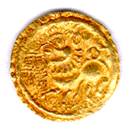
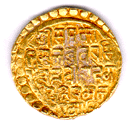
Shivachitta Paramadideva
1147-1187 AD
Gold stater/Pagoda
Obverse: Lion walking, Cyclical date, Visa
Reverse (enlarged): 5 line Legends in Devnagri script
Weight: 4.4 gms
Reference: Mitchiner1998:238
Scarce
This family mainly ruled in the Goa region and lime Hangal Kadambas, minted one of the finest example of medieval Indian coinage. THe coin shown above is minted by Shivachiita, the ruler of this dynasty. It shows lion walking on obverse. In front of the lion is the cyclical date, Visa. We have not yet deciphered the conversion of cyclical year dating to AD equivalent as yet. The reverse shows the legend written in Devnagri script. The legend reads Sri Saptakotisa Labdhavara Shivachitta Vira Hemadideva-ra Malava-rama-ri. The rulers of this dynasty often took the title, Malava-rama-ri which means rulers/conquerors of Malava (perhaps Malvan region of Konkan).
The Vijayanagar Empire
Foundation of Vijaynagar empire is certainly the most significant event in the history of medieval India. It lasted for 3 centuries and successfully prevented the extension of Muslim sultanates in south. History of Vijaynagar empire is truly an unbroken era of bloody wars with Bahamani and other Muslim sultanates of south India. Two brothers, Harihara Raya and Bukka Raya laid the foundation of the Vijaynagar city (literally City of Victory) on the southern bank of Tungabhadra river near Anegundi fortress. A sage Madhav Vidyaranya and his brother Sayana (his commentary on Vedas is famous) were the inspirational source for the foundation of this Hindu empire in then Islamic India. Bukka Raya sent an embassy to China in 1374 and after his death was succeeded by Harihara II. Harihara II extended this newly founded kingdom by conquoring almost whole of southern India, including Mysore, Kanara, Chingalpet, Trichinopally and Kanchivaram. Harihara II was devotee of Virupaksha (Shiva) but was tolerant to all other religions. He was the first King of Vijaynagar empire who assumed the title of Maharajadhiraj Rajaparmeshwara.
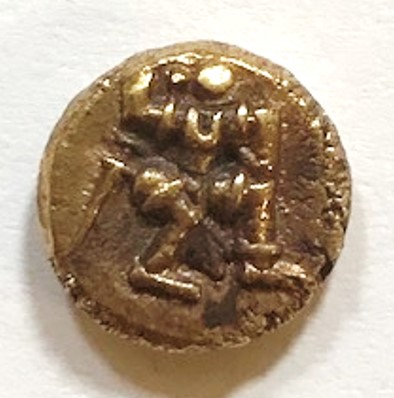

BukkaRaya I
1354-1377 AD
Gold Pagoda/Varaha
Obverse: Warrior, right hand raised up as in act of striking, Sword by waist
Reverse: 3 line Legends in Telugu-Kannada, Sri Vira Bukka Raya
Weight: 3.3 gms
Reference: K Ganesh 2.1
Scarce
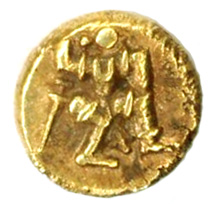
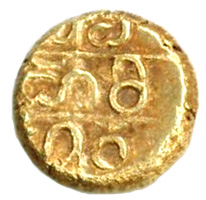
Hari Hara Raya I
1336-1354 AD
Gold Pagoda/Varaha
Obverse: Warrior, right hand raised up as in act of striking, Sword by waist
Reverse: 3 line Legends in Telugu-Kannada, Sri Vira HariHara
Weight: 3.3 gms
Reference: Girijapathi 2
Scarce
In 1486, Vir Narasimha of Chandragiri, who had rose into prominence, took control of the Vijaynagar empire. This led to the direct rule of the Tuluva dynasty over Vijaynagar empire. His younger son Krishanadev Raya is certainly the greatest ruler of Vijaynagar and one of the famous kings of India. He was gallant warrior and like Vikramaditya, he was often victorious in the wars which he waged throughout his reign. He was also a fine statesman and treated the defeated enemy with honor. In 1511-1512 AD, he captured southern Mysore, Shivasamudram fortress and Raichur. Soon, 1513 AD, he humbled the king of Orissa Gajapati and in 1514 AD he captured Udaigiri. Eventually he captured Vishakapatnam and completely abolished the authority of King of Orissa. His greatest and the most celebrated military achievement was crushing defeat of Ismail Adil Shah on 19th March 1520. This ended the dominance of sultanates in south and made him the major power-broker of south India.
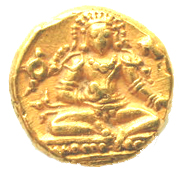
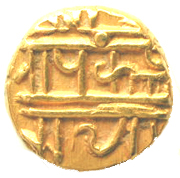
KrishnaDevRaya
1509-1529 AD
Gold half Pagoda
Obverse: BalaKrishma seated
Reverse: 3 line Legends in Devnagri script, Sri Pratap KrishNa (Dev) Raya
Weight: 1.67 gms
Reference: Mitch-MSI #641-644
Scarce
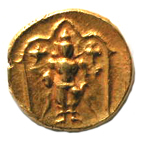
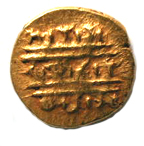
Venkatapati Raya
1630-1641 AD
Gold half Pagoda
Obverse: Lord Venkateshwara
Reverse: 3 line Legends
Weight: 1.67 gms
Reference: Mitch #919
Scarce
Shown above is a fine example of his coin. It shows Balakrishna seated on obverse of coins while on reverse his name is written Sri Pratapa Krishna Dev Raya, in Devanagri script. The coins of Vijayanagar empire were very popular and were used as prototype even after its decline. Most dynasties in south (which include British and other European colonies too) issued coins very similar to Vijayanagar coins till the beginning of the eighteenth century.

AchyutaRaya
1529-1542 AD
Gold Pagoda
Obverse: 2-headed eagle Gandabherunda holding 4 elephants
Reverse: 3 line Legends
Weight: 3.4 gms
Reference: Mitch KA 673
Rare
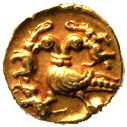
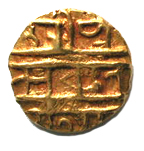
AchyutaRaya
1529-1542 AD
Gold half Pagoda
Obverse: 2-headed eagle Gandabherunda holding 4 elephants
Reverse: 3 line Legends
Weight: 1.67 gms
Reference: Mitch KA 673
Scarce
During his last days, Krishanadev Raya devoted all his attention in organization of his empire and improving the administration. He maintained friendly relationship with Portugese and granted some concessions to governor, Albuquerque. Reign of Krishanadev Raya reached to its zenith not only in terms of expanse of the empire, but also in terms of growth and development of literature, music, art and culture. Raya himself was an accomplished poet, musician, scholar and was fluent in Sanskrit, Telugu and Kannada. He wrote a immensely important (both historically and religiously) book Amuktamalyada in Telugu. He patronized many poets which includes Ashtadiggajas (eight elephants, the 8 great poets of Telugu) and scholars like Tenalirama. His reign also saw the remarkable development in art and architecture. The famous Hazara temple built during his reign is one of the fine example of Southern Temple architecture. Vithalaswami temple is another fine example of the Vijayanagar style of architecture. Krishandev Raya and all other rulers of this empire were pious and were devoted to Dharma, but they had very liberal outlook for other religions. According to Barbosa, a historian and many contemporary travelers, `the Kings allows such freedom that every man would live without suffering and annoyance, whether he is a Christian, Jew, Moor or Hindu’.
Achyut Raya succeeded as the ruler of empire; he minted some interesting coins showing a mythical 2-headed eagle, GandaBherunda, that had strength of carrying 4 elephants! This motif became so popular that later it was adopted as an official state emblem by Wodeyar dynasty of Mysuru and the modern state of Karnataka. The GandaBherunda was also shown on Hoysal coins, shown abive. There are two types Vijayanagar GandaBherunda types: an emblem form (left specimen above) and the second, bird walking (right specimen above). Both these types are shown. The reverse of these coins have the legend Sri Pratapa (A)chyut Raya in Devanagri script. These coins were minted in two denomination, the common half pagoda (1.67 gms) and rare, full pagoda (3.4 gms). The left picture is of full pagoda.
Shown on right is the a carving located in the Rameshwara temple in town, Keladi (modern Karnataka state), built by Nayaka dynasty, who rose to power after the fall of Vijayanagar. This carving clearly shows the motif of GandaBherunda holding two elephants in beaks and two in its talons.
